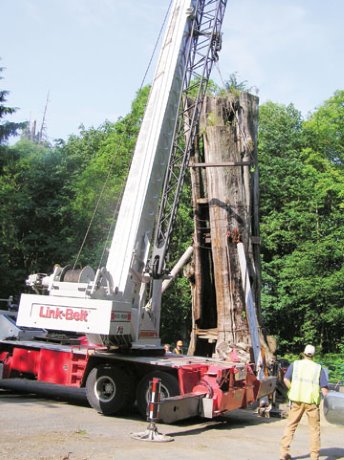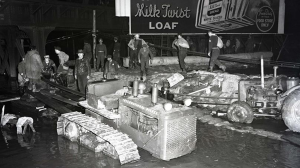British Columbia contractors have pitched in to help preserve a Vancouver landmark, the Stanley Park Hollow Tree, estimated to be 700 to 1,000 years old. A December 2006 winter storm damaged the oft photographed tree, causing an 11-degree angle list. The tilt prompted the Vancouver Parks Board to have the tree felled until the Stanley Park Hollow Tree Conservation Society successfully rallied contractors and donations for a fix.
Vancouver
British Columbia contractors have pitched in to help preserve a Vancouver landmark, the Stanley Park Hollow Tree, estimated to be 700 to 1,000 years old.
The often-photographed tree has been dead for the past 200 years, but it still towers 44 feet in the air.
It was hollowed out by a lightning strike and first photographed in the 1880s.
A December 2006 winter storm further damaged it, causing an 11-degree angle list. The tilt prompted the Vancouver Parks Board to have the tree felled until the Stanley Park Hollow Tree Conservation Society (SPH-TCS) successfully rallied contractors and donations for a fix.
The first phase of a $150,000 to $200,000 restoration begin recently as project crews rolled onto the Third Beach site with lift truck, backhoe and a 60-ton crane aimed at propping up the stump upright again.
“With a bit of luck, we should be able to take the tree back near to plumb,” said Gordon Macdonald, partner in Macdonald & Lawrence Timber Framing (M&L) of Cobble Hill, B.C.
The company led a stabilization plan in early 2008, which was aimed at preventing the tree from toppling over until the SPH-TCS could raise restoration funds.
The work involved installing two temporary support timbers and two temporary guy wires to stabilize it.
A major concern during the recent righting was that the hollow cylindrical stem would collapse during the lift.
The M&L crew spent the morning of June 11 placing straps around the tree with the aid of a lift truck and also providing timber braces inside the tree in preparation for the afternoon lift by the Link-Belt HTC-1060 with a 75-foot boom.
Les Abraham, with Consolidated Mobile Crane Inc., said the lift had to be done extremely carefully.
“It’s a hollow tree and you have to be careful what you do or you end up with a lot of kindling,” he said.
Crane operator Brent Aumann successfully lifted the 20,000 pound stump.
Lorne Whitehead, with the preservation society, said the rescue was prompted after careful analysis of the tree’s roots found only two key areas where roots still extended into the ground.
“We are using them to our advantage to support the tree,” he said.
As the tree hollow was lifted up, two timber supports — attached by plates to the tree in 2008 — were again used to keep the tree in the new position.
As well, additional timber was used to keep the tree in its new position.
The upright position will allow the second phase of work to begin soon.
It involves building a permanent, but hidden foundation support for the tree.
A trench will be dug around the tree and micro-piles, one-inch steel rods, will be driven into the ground.
They will extend into a collar of cement that will ring the roots of the tree at below grade level.
Micro-piles will also be driven from the concrete foundation into the wooden base of the stump to stabilize it.
Rodney Hicks, sales manager for Ocean Concrete, met with several SPH-TCS members, and agreed to donate the concrete. He expects it will take a load or two of concrete to pour the foundation using regular structural grade.
Bayline Construction Ltd. will form and place the concrete.
Troy Beaupre, with the company, said he was originally consulted about the feasibility of anchoring the tree with a cement collar, while visiting the site with several others involved in saving the tree stump.
An engineering firm, Cascade Engineering Group out of Canmore, Alberta, is providing drawings and Beaupre volunteered his company.
The micro-piles are being supplied by Conn-Tech Systems, while Belpacific Excavating and Shoring will plant the micro-piles.











Recent Comments
comments for this post are closed